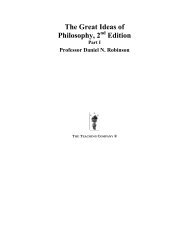English idioms in the first language and second language lexicon: a ...
English idioms in the first language and second language lexicon: a ...
English idioms in the first language and second language lexicon: a ...
Create successful ePaper yourself
Turn your PDF publications into a flip-book with our unique Google optimized e-Paper software.
3 Conceptual representationsBeate Abel 347Third assumption: If decomposable <strong>idioms</strong> lack an idiom entry at<strong>the</strong> lexical level, conceptual representations are accessed dur<strong>in</strong>gcomprehension. Conceptual representations are nonl<strong>in</strong>guisticentities that organize world knowledge <strong>and</strong> are represented at ageneral cognitive level. With regard to <strong>the</strong> <strong>language</strong> system <strong>the</strong>y areautonomous, which means that <strong>in</strong> spite of l<strong>in</strong>ks that may existbetween conceptual <strong>and</strong> lexical representations, <strong>the</strong>re is no directanalogy or one-to-one correspondence between <strong>the</strong> two. Theseparability of lexical mean<strong>in</strong>g <strong>and</strong> conceptual knowledge issupported by many empirical studies, especially <strong>in</strong> <strong>the</strong> context ofbil<strong>in</strong>gual memory (e.g., Potter et al., 1984; Potter <strong>and</strong> Kroll, 1987; deGroot 1992; Kroll <strong>and</strong> Sholl, 1992; Kroll, 1993; Kroll <strong>and</strong> Stewart,1994). Conceptual representations do not have to be retrieved as awhole. Partial access is possible, depend<strong>in</strong>g on <strong>the</strong> aspects relevant<strong>in</strong> each context.As far as idiom process<strong>in</strong>g is concerned, it is assumed that at leastfor some <strong>idioms</strong> conceptual metaphors <strong>in</strong> <strong>the</strong> sense of Lakoff <strong>and</strong>Johnson (1980) are activated, such as ‘anger is heated fluid <strong>in</strong> aconta<strong>in</strong>er’ or ‘anger is fire’, which motivate <strong>the</strong> mean<strong>in</strong>g of <strong>idioms</strong>like smoke was com<strong>in</strong>g out of his ears, she was spitt<strong>in</strong>g fire, he wasfum<strong>in</strong>g, etc. O<strong>the</strong>r <strong>idioms</strong>, e.g., miss <strong>the</strong> boat or pass <strong>the</strong> hat, whereone constituent has a metaphorical read<strong>in</strong>g, probably activateconceptual <strong>in</strong>formation with regard to this read<strong>in</strong>g. Some <strong>idioms</strong>are not conceptually motivated at all, e.g., kick <strong>the</strong> bucket. Thisshows that conceptual or metaphorical motivation cannot beautomatically equated with predictability of idiomatic mean<strong>in</strong>g.Gibbs (e.g., 1990; 1992; 1995), Gibbs <strong>and</strong> O’Brien (1990), Nayak<strong>and</strong> Gibbs (1990), Glucksberg et al. (1993), Cacciari <strong>and</strong> Glucksberg(1995), among o<strong>the</strong>rs, have conducted empirical studies <strong>in</strong> order todeterm<strong>in</strong>e <strong>the</strong> degree to which conceptual structures or metaphorsmotivate <strong>the</strong> mean<strong>in</strong>g of <strong>idioms</strong> (but, for an oppos<strong>in</strong>g approach, seeKeysar <strong>and</strong> Bly, 1999). Results lead to two different perspectives:on <strong>the</strong> one h<strong>and</strong>, Gibbs <strong>and</strong> his colleagues assumed that conceptualstructures motivate <strong>the</strong> mean<strong>in</strong>g of <strong>idioms</strong>. Their reaction timestudies have shown that conceptual metaphors are automaticallyactivated dur<strong>in</strong>g idiom comprehension. On <strong>the</strong> o<strong>the</strong>r h<strong>and</strong>,Glucksberg <strong>and</strong> his colleagues have not found evidence forautomatic activation; <strong>the</strong>y claim that ‘conceptual analogies playlittle, if any, role <strong>in</strong> idiom comprehension unless people have<strong>the</strong> time (<strong>and</strong> motivation) to make considered judgements’(Glucksberg et al., 1993: 711).The DIR Model can clarify this ambiguous situation <strong>in</strong> that itDownloaded from http://slr.sagepub.com at Shanghai Jiaotong University on March 7, 2009














